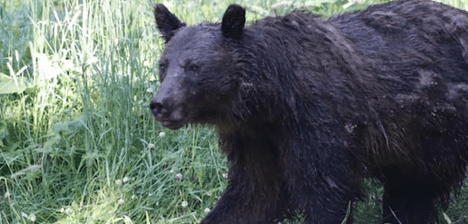 Photo credit T.J. Altieri Photo credit T.J. Altieri Written By: Jim Knox Featured in Greenwich Sentinel Cryptic at first, I glimpsed the great creature’s form through the dappled early morning light filtering through the Lodgepole pines. Brief and tantalizing, my view disappeared as she ambled behind dense foliage. With such a rare sighting, thankfully, I was not alone. Guided by the Yellowstone Forever Institute, my colleagues and I were leading students from Connecticut’s Beardsley Zoo’s Conservation Discovery Corps on our inaugural Yellowstone National Park Eco-Expedition. Hunkered in the institute’s compact bus, our excited chatter drew to a hush. With excitement masked as patience, we waited. After a time, the rustling of pine boughs marked the animal’s movement just 25 feet away, and then she lumbered out from the realm of wilderness legend and into the same bright morning sunlight we beheld as if she owned the place—which in essence, she did. In that moment, my expedition mates and I beheld one of nature’s true wonders—a creature whose mere presence evokes silence and awe. The Grizzly bear, Ursus horribilis, is a beast which eludes both the camera and conventional definition. Referred to as “a creature of roar and lore” it is both a very real and vital inhabitant of wilderness ecosystems, and simultaneously a creature roaming the untrod wilderness of our minds. Ranging from 6.5 feet in length and more than 350 pounds for a small female or sow, to 9 feet in length and more than half a ton for a large male or boar, Grizzlies are wilderness behemoths. A timeless symbol of the rugged American West, “The Golden Bear” stands as the state animal of California. While its size alone inspires awe, it is the Grizzly’s behavior which inspires other emotions.
When first encountered by the Lewis and Clark expedition, their native guide, Sacagawea warned the explorers not to shoot Grizzlies because it would only anger them. Accustomed to shy, easily intimidated Black bears, the Lewis and Clark party soon discovered the great bears could not be felled by a single musket ball or even two, and that—for the safety of their party—it was best to give a wide and respectful berth to the often unpredictable and ferocious bears. In fact, the origin of their scientific name—” The Horrible Bear” was earned by innumerable encounters with a creature that was as wild and unconquerable as the wilderness they inhabited. Named for their silvery “grizzled” tipped hairs, Grizzlies exhibit a variety of coat colors, from light blond, to golden, chocolate brown, to black, all often possessing the silvery grizzled sheen. While Grizzlies possess the hallmark huge rounded muscular bodies of the bear family, they differ from the other seven species in possessing pronounced facial disks, straight 4-inch-long claws, and a distinctive shoulder hump which confers tremendous power for flipping boulders and digging up prey, roots, and other foods. With a highly varied and adaptable diet encompassing hundreds of plant and animal species from Buffalo berries to Cutthroat trout, and the unmatched ability to take down the largest prey including elk, moose, and bison, omnivorous Grizzlies dominated the North American landscape from present day Alaska and Canada, down through the mountains of Mexico and from Pennsylvania westward to the Pacific. Between their close cousins, the Eurasian Brown bears, and their coastal relatives, The Kodiak and Kamchatka bears, the solitary Grizzly historically roamed one of the largest home ranges of any mammal species on the planet! Yet, the enormous chocolate brown mammal we beheld that day was not exhibiting the anticipated ferocity of an apex predator, she was displaying attentiveness and patience with her three small cubs who followed her with the playful vitality of all healthy wild creatures. Privy to a tender moment between a mother Grizzly and her young—the only known sow with three cubs in the entire Yellowstone ecosystem—we treasured this rarely open window on their world. We would later learn that the sow had shifted her territory 14 miles in just a week in search of better hunting and foraging to help her produce more milk to feed her rapidly growing family. While I have studied Grizzlies in the wild, it was this moment that gave me an appreciation for another side to the great beasts. Like the iconic and infinitely varied wilderness that is Yellowstone, the Grizzly has many faces. In observing the bears with our team, I learned more about the Grizzly than I would have through solo observation. The awe, respect, and wonder we experienced that golden Yellowstone morning was shared and its impact, indelible. We will never be quite the same. What can the great bear teach us? We too are varied, often fierce, unpredictable, tender. While we must retain our adaptability, we must never relinquish our desire to roam and explore new territories. We must not shy away from challenges or challengers. We must focus on our little ones and guide them in the world in which we dwell, which is often far more uncertain than the geysers of Yellowstone. In short, we must adopt the spirit of the forever wild and unconquerable Grizzly to walk with the confidence to make our tracks where none have trod before.
0 Comments
Leave a Reply. |
Archives
July 2024
|
Connecticut’s Beardsley Zoo is dedicated to acquainting a diverse public to the delicate balance that exists between living things and their environment.
Connecticut's Beardsley Zoo is a 501(c)(3) not for profit owned and operated by the Connecticut Zoological Society.
Connecticut's Beardsley Zoo is a 501(c)(3) not for profit owned and operated by the Connecticut Zoological Society.
© 2022 Connecticut's Beardsley Zoo

 RSS Feed
RSS Feed





